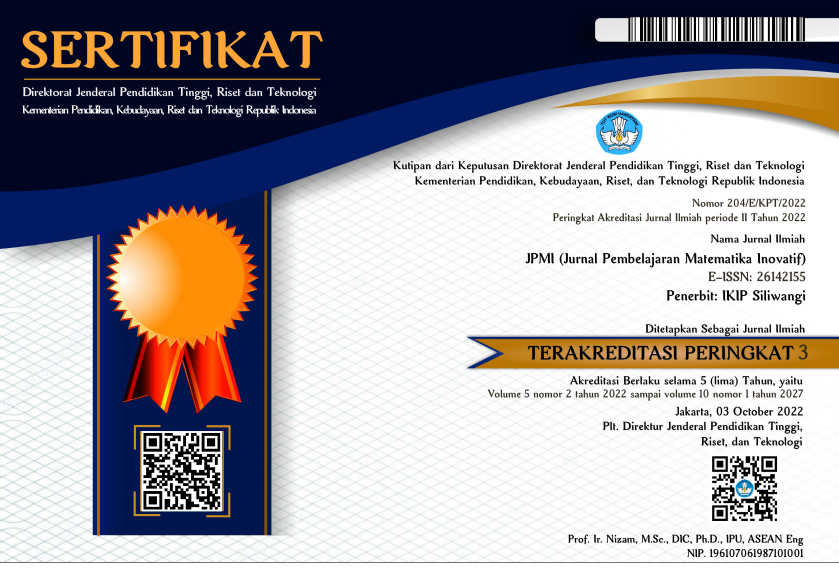Analisis disposisi matematis mahasiswa universitas Nurtanio Bandung melalui metode Video Based Learning (VBL)
DOI:
https://doi.org/10.22460/jpmi.v8i2.27031Keywords:
Mathematical disposition; Video Based LearningAbstract
The low mathematical disposition of students is the background of this study. The aim is to analyze the mathematical disposition of students through a set of mathematical disposition scales using the Likert scale. 2 classes were taken as research samples through simple random sampling techniques. The research design used was Posttest-Only Control Design. The method used was the quasi-experimental method. The data analysis technique was descriptive statistics, then the Mann Whitney non-parametric test was carried out. A conclusion was obtained that the mathematical disposition of students with the application of the VBL method was better than the mathematical disposition of students with the application of the conventional method where the class with the VBL method showed a percentage of 76% in the moderate category and the class with the conventional method showed a percentage of 60% in the poor category.
References
Agustianti, R. (2021). Analisis disposisi matematis mahasiswa dengan menggunakan model pembelajaran CORE (Connecting, Organizing, Reflecting, Extending). JPMI – Jurnal Pembelajaran Matematika Inovatif, 4(6), 1405–1412.
Al Faraby, M. C., Malik Frederick, J. T., & Mahardhika P Wildan Hakim, R. A. (2021). Inovasi video based learning dalam meningkatkan interaksi pada proses belajar mengajar. Kumpulan Karya Tulis Ilmiah Tingkat Nasional, 43–55. https://journal.ittelkom-sby.ac.id/lkti/article/download/116/86/525
Busyaeri, A. (2016). Pengaruh penggunaan video pembelajaran terhadap peningkatan hasil belajar mapel IPA di MIN Kroya Cirebon. Al Ibtida.
Dina, A., Mawarsari, V. D., & Suprapto, R. (2015). Implementasi kurikulum 2013 pada perangkat pembelajaran model discovery learning pendekatan scientific terhadap kemampuan komunikasi matematis materi geometri SMK. Jurnal Karya Pendidikan Matematika, 2(1), 22–31.
Diningrum, P. R., Azhar, E. & Faradillah, A. (2018). Hubungan disposisi matematis terhadap kemampuan komunikasi matematis siswa kelas VII di SMP Negeri 24 Jakarta. Pendidikan Matematika, 01, Pp. 352–364.
Ermayasari, E. & Yadi, F. (2013). Hubungan antara ranah afektif siswa dengan hasil belajar pada mata pelajaran sistem pengelasan di SMK N 1 Indralaya Utara Tahun 2013. Ejournal.Unsri.Ac.Id,.
Febriyani, A., & Hakim, A. R. (2022). Peran disposisi matematis terhadap kemampuan pemahaman konsep matematika. 2, 87–100.
Husnul, H. K., Asdarina, O., & Rismawati. (2023). Kemampuan disposisi matematis mahasiswa stkip muhammadiyah Aceh Barat Daya. PERISAI: Jurnal Pendidikan Dan Riset Ilmu Sains, 2(1), 1–14. https://doi.org/10.32672/perisai.v2i1.73
Machmud, T., Pusi, R. A., & Pauweni, K. A. Y. (2022). Deskripsi disposisi matematis mahasiswa pada mata kuliah kalkulus 1. Mosharafa: Jurnal Pendidikan Matematika, 11(3), 349–358. https://doi.org/10.31980/mosharafa.v11i3.726
Mendrofa, R. N., & Sinaga, B. (2024). Pengaruh disposisi matematis terhadap kemampuan pemecahan masalah dengan pembelajaran berbantuan video. 9(3), 1539–1546.
Monsiah, R. (2022). Penerapan metode video based learning dalam peningkatan disiplin belajar PAI siswa kelas XI di SMA Negeri 1 Sinabang. 89. http://www.nber.org/papers/w16019
Muallif. (2024). Kelebihan dan kekurangan video pembelajaran. https://an-nur.ac.id/kelebihan-dan-kekurangan-video-pembelajaran/
Pujiati. (2023). Sekilas tentang pengertian modul pembelajaran dan fungsi utamanya. https://duniadosen.com/pengertian-modul/
Ruhiyat, A. & Sugandi, A. I. (2017). Meningkatkan kemampuan berpikir kreatif serta disposisi matematik siswa SMP melalui pendekatan kontekstual. Edusentris, 3(3), p. 281. Doi: 10.17509/Edusentris.V3i3.238.
Setiawan, B., Amarthani, S. I., & Akhyar, S. N. (2021). Efektivitas penggunaan video based learning pada pembelajaran jarak jauh pendidikan anak usia dini. jurnal teknologi pendidikan (jtp), 14(2), 101. https://doi.org/10.24114/jtp.v14i2.25814
sholikhah, u. (2014). penerapan model eliciting activities (mea) sebagai upaya meningkatkan kemampuan pemecahan masalah dan disposisi matematis siswa kelas ix b mts taris lengkong batangan pati materi pokok bangun ruang sisi lengkung tahun pelajaran 2014/2015. 57–76.
trisnowali, a., & aswina, a. (2019). pengaruh model pembelajaran core (connecting, organizing, reflecting and extending) terhadap hasil belajar siswa kelas X. DIDAKTIKA : Jurnal Kependidikan, 13(1), 43–55. https://doi.org/10.30863/didaktika.v13i1.315
Yolanda, S. B., Mahardika, I. K., & Wicaksono, I. (2021). Penggunaan media video sparkol terhadap kemampuan berpikir kreatif siswa pada pembelajaran ipa di SMP. 9(2), 189–203.
Yuanari. (2011). Pengembangan berpikir kritis dan kreatif. Social Education.
Zubaedah, N., & Efendy, R. (2023). Penerapan pembelajaran video based learning di madrasah aliyah negeri 2 Kota Parepare. DIALEKTIKA : Jurnal Pendidikan Agama Islam, 2, 1–9.
Downloads
Published
Issue
Section
License

This work is licensed under a Creative Commons Attribution-ShareAlike 4.0 International License.
The author is responsible for acquiring the permission(s) to reproduce any copyrighted figures, tables, data, or text that are being used in the submitted paper. Authors should note that text quotations of more than 250 words from a published or copyrighted work will require grant of permission from the original publisher to reprint. The written permission letter(s) must be submitted together with the manuscript.
















